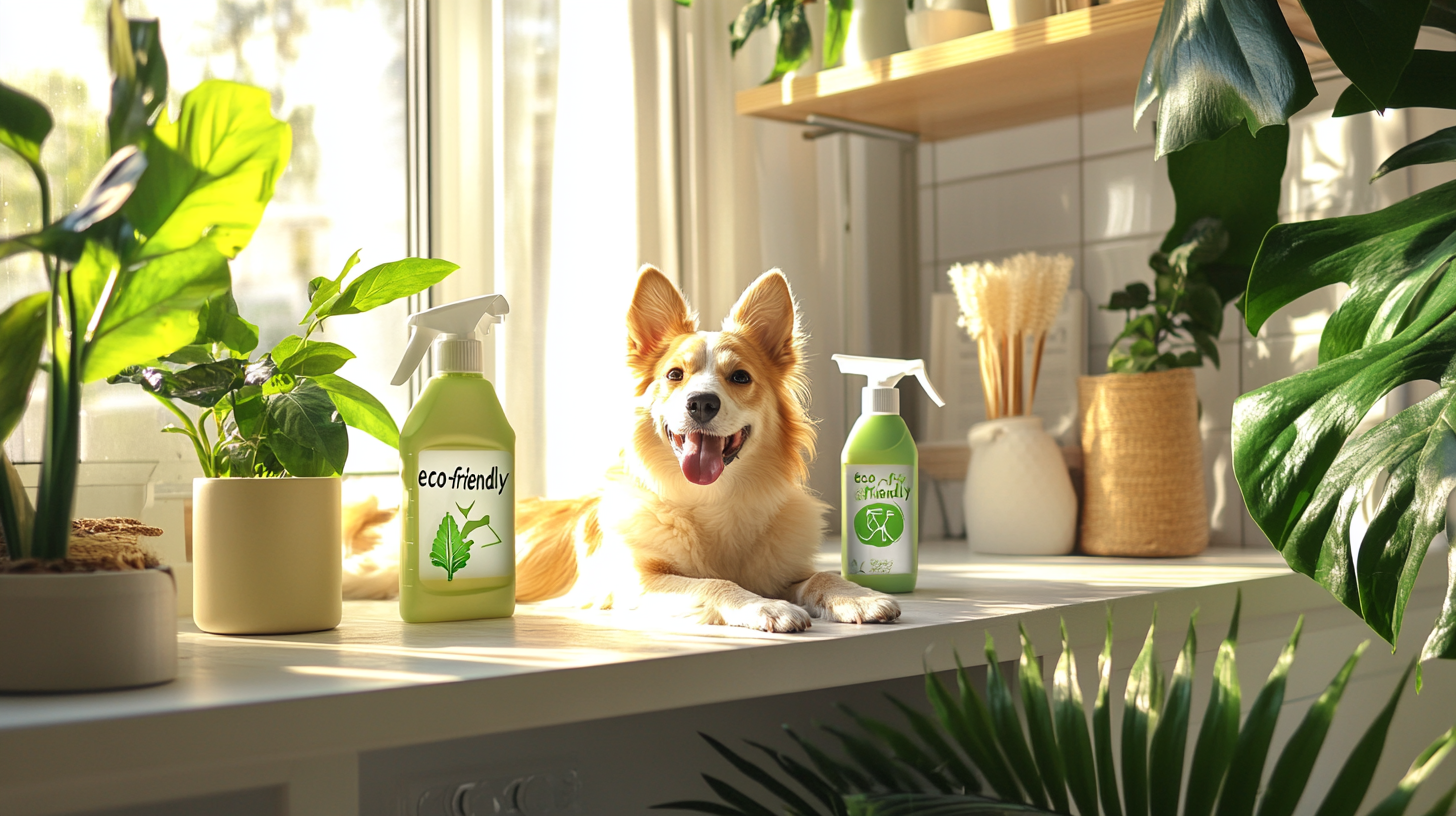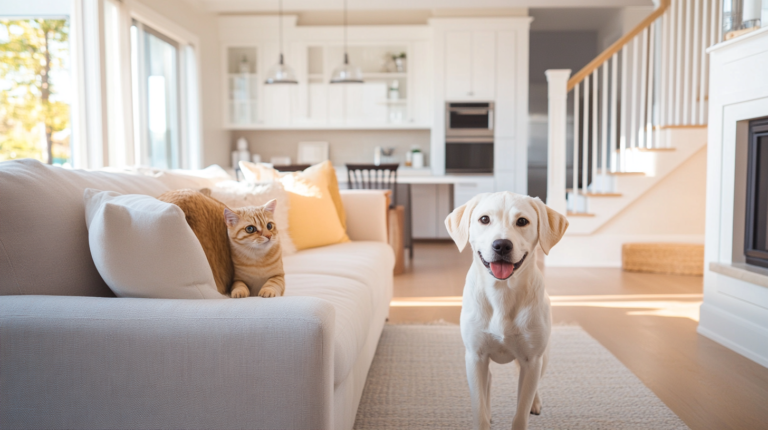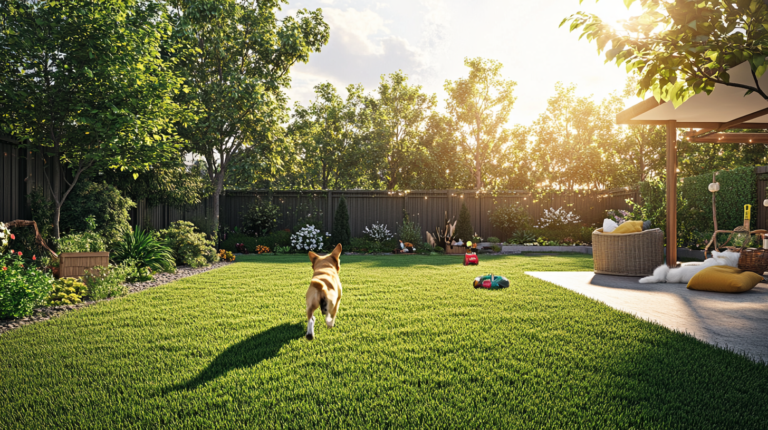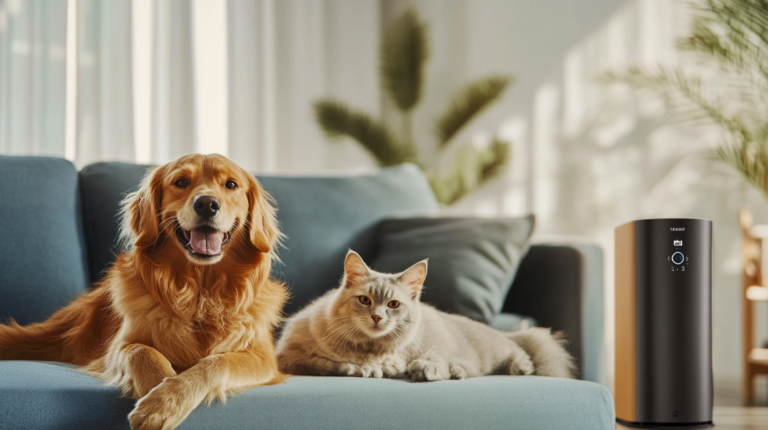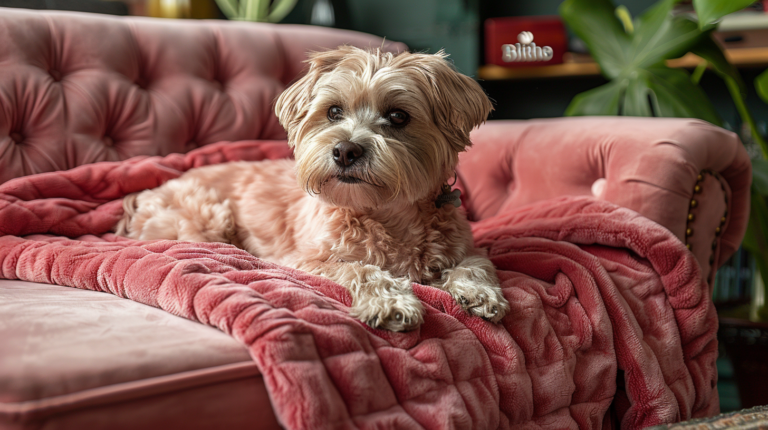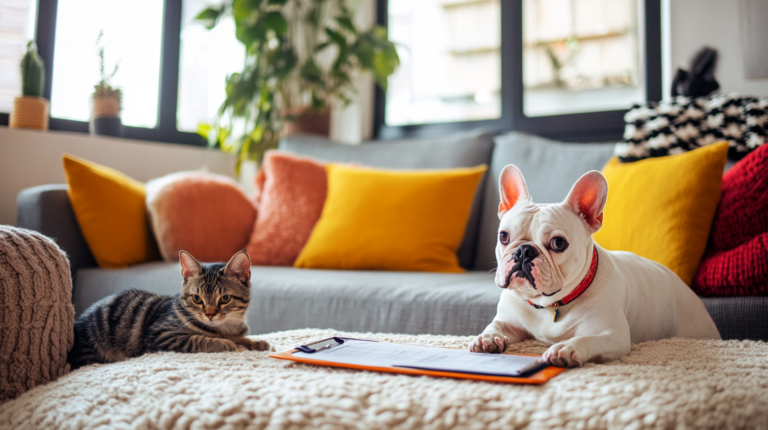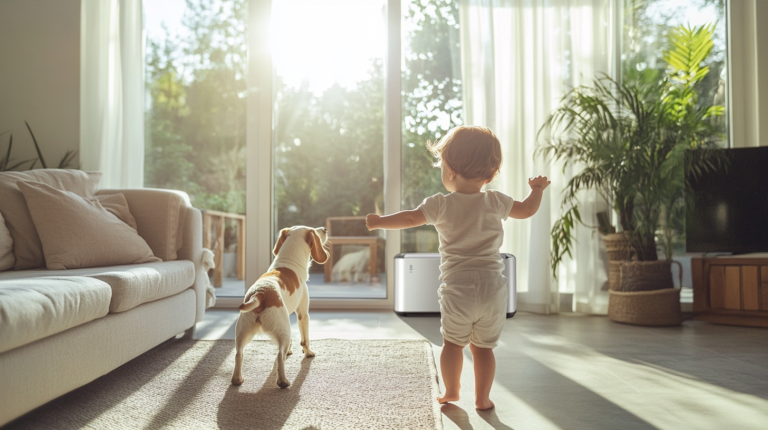Discover the top 5 pet safe cleaning products of 2025 that effectively clean your home without harming your furry friends. Expert tips for non-toxic cleaning solutions.
Table of Contents
Introduction: Why Pet Safe Cleaning Products Matter
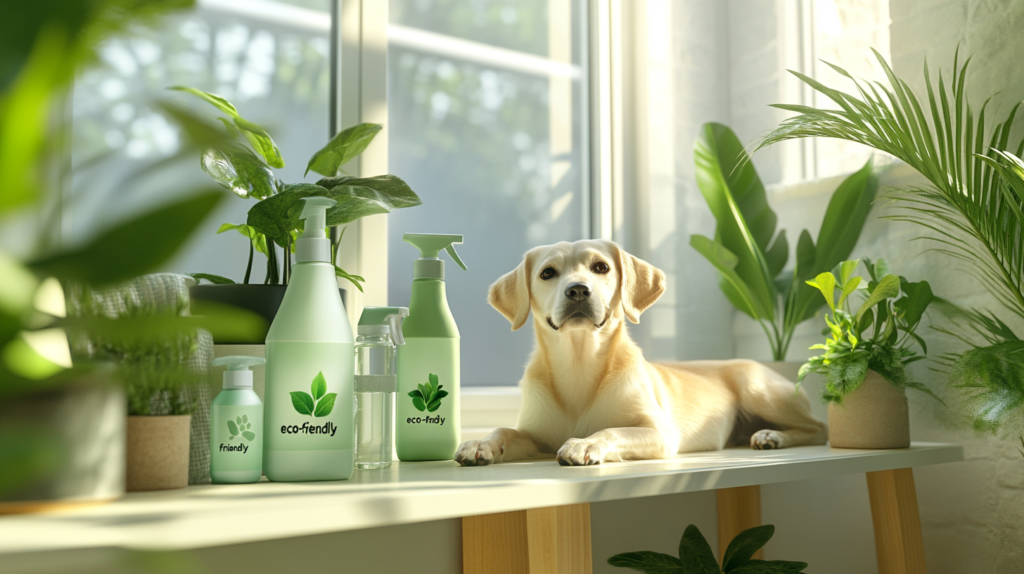
As pet parents, we all want our homes to be clean and our pets to be healthy. However, many conventional cleaning products contain chemicals that can pose serious health risks to our furry, feathered, or scaled companions. From respiratory issues to skin irritations and even poisoning, the dangers lurking in standard household cleaners are very real threats to our pets’ wellbeing.
Pets are particularly vulnerable to cleaning chemicals for several reasons. Their smaller bodies process toxins differently than humans, they often walk barefoot through freshly cleaned areas, and many animals (especially cats and dogs) frequently groom themselves, ingesting whatever residues may be on their fur or paws. Additionally, curious pets might directly ingest cleaning products left within their reach.
According to the ASPCA Animal Poison Control Center, cleaning products consistently rank among the top ten pet toxins, with over 20,000 cases of household cleaner exposure reported annually. This statistic alone highlights the critical importance of switching to pet safe cleaning products.
In this comprehensive guide, we’ll explore the top 5 pet safe cleaning products available today, what makes them safe, harmful ingredients to avoid, and how to maintain a clean home without compromising your pet’s health. We’ll also share expert tips on transitioning to a pet-friendly cleaning routine and address common questions pet owners have about safe cleaning practices.
Understanding the Dangers: Common Toxic Ingredients in Conventional Cleaners
Before diving into our recommended pet safe cleaning products, it’s important to understand exactly what makes conventional cleaners so dangerous for our animal companions.
Harmful Chemicals to Avoid
Phenols and Phenolic Compounds
Found in many disinfectants and all-purpose cleaners, phenols can cause severe liver damage, especially in cats whose bodies cannot efficiently metabolize these chemicals. Products containing pine oil, cresol, or ingredients with “phenol” in their name should be avoided in pet households.
Dr. Karen Becker, a prominent veterinary expert, warns: “Phenols are particularly toxic to cats as they lack the liver enzymes needed to break these chemicals down, which can lead to liver failure even from minimal exposure.”
Ammonia
A common ingredient in glass and bathroom cleaners, ammonia releases fumes that can irritate pets’ respiratory systems and eyes. For birds, whose respiratory systems are especially sensitive, ammonia exposure can be fatal.
Chlorine Bleach
While effective at killing germs, chlorine bleach can cause irritation to pets’ eyes, nose, throat, and lungs. If ingested, it can cause severe damage to the digestive tract. When mixed with other cleaning products containing ammonia, it creates toxic chloramine gas that can be deadly to both pets and humans.
Phthalates
These chemicals, often found in air fresheners and products with fragrances, have been linked to hormonal abnormalities, birth defects, and reproductive problems in animals.
Formaldehyde
Hidden in many cleaning products as a preservative, formaldehyde is a known carcinogen that can cause respiratory issues and skin irritations in pets.
Glycol Ethers
Present in many all-purpose, glass, and carpet cleaners, these chemicals can cause liver and kidney damage, as well as anemia and lung irritation in pets.
Case Study: The Impact of Cleaning Products on Pet Health
A 2018 study published in the Journal of Veterinary Medicine showed a correlation between the use of conventional floor cleaners and an increased risk of respiratory issues in dogs. The study found that homes using chemical-heavy cleaners reported 40% more cases of chronic coughing and wheezing in their canine companions compared to households using natural, pet safe cleaning products.
Another telling statistic comes from the Pet Poison Helpline, which reports that approximately 15% of their calls involve household cleaning product exposures, with small dogs and curious puppies being most frequently affected.
Top 5 Pet Safe Cleaning Products for 2025
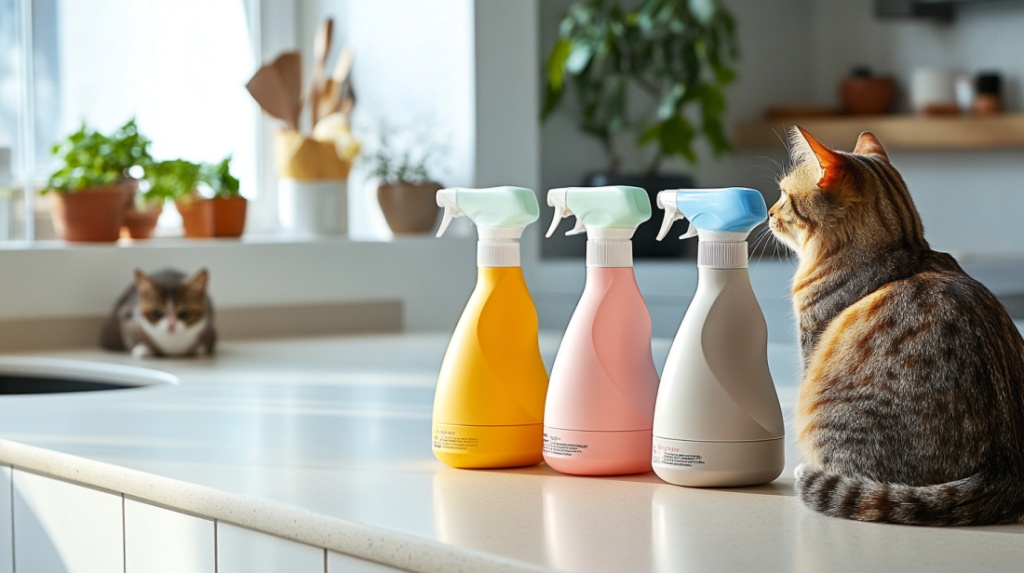
After extensive research and consultation with veterinary toxicologists, we’ve compiled our list of the top 5 pet safe cleaning products that effectively clean your home without putting your pets at risk.
1. Seventh Generation Free & Clear All-Purpose Cleaner
A bottle of Seventh Generation Free & Clear All-Purpose Cleaner – perfect for pet households seeking effective, non-toxic cleaning solutions
Why We Recommend It:
Seventh Generation’s Free & Clear line provides powerful cleaning without harsh chemicals, fragrance, dyes, or phosphates. This plant-based formula effectively removes grease and grime while being safe to use around pets.
Key Features:
- USDA Certified Biobased Product (91%)
- No harsh fumes or residues
- Effective on multiple surfaces
- Biodegradable formula
- Never tested on animals
Best Used For:
Countertops, sealed granite, tile, stainless steel, and most hard, non-porous surfaces throughout your home. It’s particularly good for kitchen surfaces where pets might jump or where food is prepared.
Expert Opinion:
Veterinary toxicologist Dr. Lisa Weeth notes, “Plant-based cleaners like Seventh Generation’s Free & Clear line are ideal for homes with pets because they break down into harmless compounds quickly, leaving no toxic residues that could be licked off paws or fur.”
2. Biokleen Bac-Out Stain & Odor Remover
Biokleen Bac-Out effectively tackles tough pet messes without harmful chemicals
Why We Recommend It:
Any pet owner knows that accidents happen. Biokleen’s Bac-Out uses live enzyme cultures to break down organic stains and odors at their source—perfect for pet households dealing with occasional messes. The natural, biodegradable formula makes it one of the best pet safe cleaning products for spot cleaning.
Key Features:
- Live enzyme-producing cultures
- Natural citrus extracts
- No artificial fragrances or dyes
- Works on multiple surfaces
- Multi-action formula that cleans, deodorizes, and removes stains
Best Used For:
Pet accidents, vomit, urine, feces, food spills, and other organic messes on carpets, upholstery, bedding, clothing, and hard surfaces.
Expert Opinion:
Professional pet trainer Emma Rodriguez states, “I recommend Bac-Out to all my clients with new puppies or kittens. Not only does it clean effectively without harsh chemicals, but the enzyme formula helps discourage pets from remarking the same spot—a crucial benefit during housetraining.”
3. Ecos Pet Stain & Odor Remover
Ecos Pet Stain & Odor Remover works effectively while keeping pets safe
Why We Recommend It:
Specifically formulated with pets in mind, this product tackles tough pet messes while being completely safe for use around animals. The plant-powered formula uses enzymes to eliminate pet odors rather than masking them, making it especially useful for households with dogs and cats.
Key Features:
- Plant-based, readily biodegradable formula
- Enzyme-powered cleaning action
- pH balanced
- No animal testing
- Works on both fresh and set-in stains
- U.S. EPA Safer Choice Certified
Best Used For:
This versatile cleaner works wonderfully on carpets, upholstery, pet bedding, crates, carriers, and even washable pet toys.
Expert Opinion:
Veterinary behaviorist Dr. Patricia McConnell recommends enzyme cleaners like Ecos: For homes with multiple pets, using enzymatic cleaners is crucial as they truly break down the biological components of urine and feces rather than just masking them, which helps prevent territorial marking behaviors triggered by residual scents.
4. Puracy Natural Multi-Surface Cleaner
Puracy Natural Multi-Surface Cleaner is safe for pets yet tough on dirt and grime
Why We Recommend It:
Developed by doctors, Puracy’s plant-based formula delivers a streak-free clean without leaving behind harmful residues. The gentle yet effective formula makes it one of the best pet safe cleaning products for daily use throughout your home.
Key Features:
- Made with plant-derived ingredients
- Hypoallergenic formula
- No harsh chemicals, SLS, triclosan, formaldehyde, parabens, phosphates, or petroleum-based ingredients
- Green tea and lime scent from natural essential oils
- 100% satisfaction guarantee
Best Used For:
Glass, countertops, floors, upholstery, granite, marble, stainless steel, and most other household surfaces. It’s especially useful as an everyday cleaner for quick wipe-downs in areas your pets frequent.
Expert Opinion:
Dr. Gary Richter, integrative veterinarian and author of “The Ultimate Pet Health Guide,” recommends, “When selecting everyday cleaners for pet households, look for plant-based products like Puracy that are effective against dirt but gentle enough that residues won’t harm pets who may walk across or lick freshly cleaned surfaces.”
5. Better Life Natural Tub and Tile Cleaner
Better Life Natural Tub and Tile Cleaner provides powerful bathroom cleaning that’s safe around pets
Why We Recommend It:
Bathroom cleaning typically involves some of the harshest chemicals in conventional cleaning products. Better Life’s Natural Tub and Tile Cleaner tackles soap scum, hard water stains, and grime without chlorine, bleach, or other toxins that could harm your pets.
Key Features:
- Plant-derived cleaning agents
- No VOCs, alkylphenol surfactants, or petroleum solvents
- Cruelty-free and never tested on animals
- No rinsing needed
- Tea tree and eucalyptus scent from natural essential oils
Best Used For:
Bathtubs, shower doors, tile, grout, fixtures, and sinks. It’s particularly valuable for pet owners who bathe their animals in the bathtub, as residues from conventional bathroom cleaners can irritate pets’ skin and paws.
Expert Opinion:
Holistic veterinarian Dr. Judy Morgan recommends, “For homes where pets are bathed in the tub, using a non-toxic cleaner like Better Life is essential. Many skin issues I treat in pets stem from contact with chemical residues left behind by conventional bathroom cleaners.”
Comprehensive Comparison of the Top 5 Pet Safe Cleaning Products
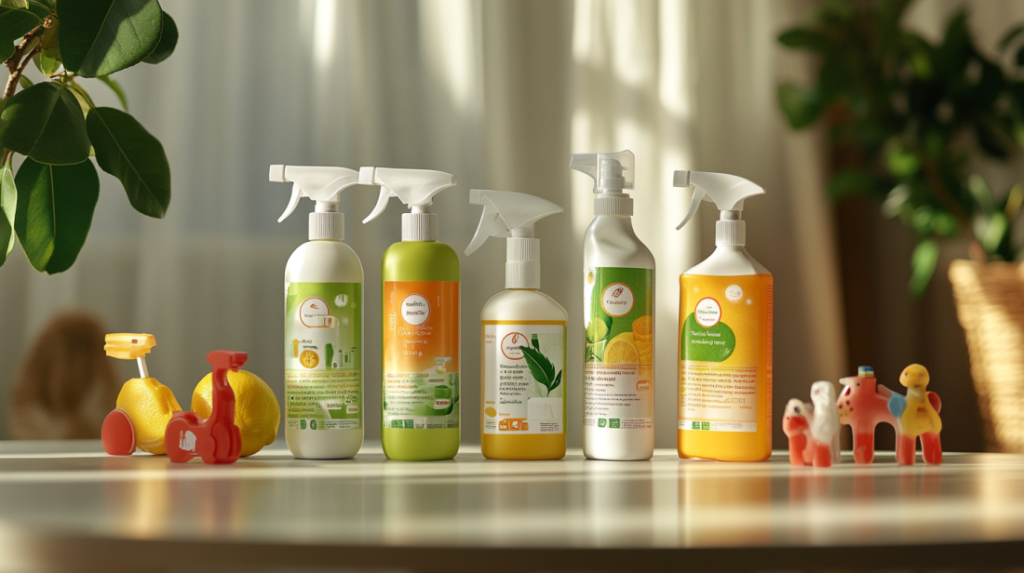
To help you choose the right product for your specific needs, here’s a detailed comparison of our top recommendations:
| Product | Best For | Key Ingredients | Price Range | Eco-Friendly Rating | Effectiveness Rating |
| Seventh Generation Free & Clear All-Purpose Cleaner | Daily cleaning of most surfaces | Water, caprylyl/myristyl glucoside, sodium citrate | $$ | ★★★★★ | ★★★★☆ |
| Biokleen Bac-Out Stain & Odor Remover | Pet accidents and organic stains | Live enzyme cultures, citrus extracts, plant-based surfactants | $$ | ★★★★☆ | ★★★★★ |
| Ecos Pet Stain & Odor Remover | Set-in pet stains and odors | Plant-based surfactants, enzymes, purified water | $$ | ★★★★★ | ★★★★☆ |
| Puracy Natural Multi-Surface Cleaner | Everyday cleaning and glass | Purified water, plant-based surfactants, green tea extract, lime oil | $$$ | ★★★★★ | ★★★★★ |
| Better Life Natural Tub and Tile Cleaner | Bathroom surfaces and grout | Lactic acid, sodium citrate, sodium gluconate, natural essential oils | $$ | ★★★★☆ | ★★★★☆ |
DIY Pet Safe Cleaning Solutions: Effective Alternatives
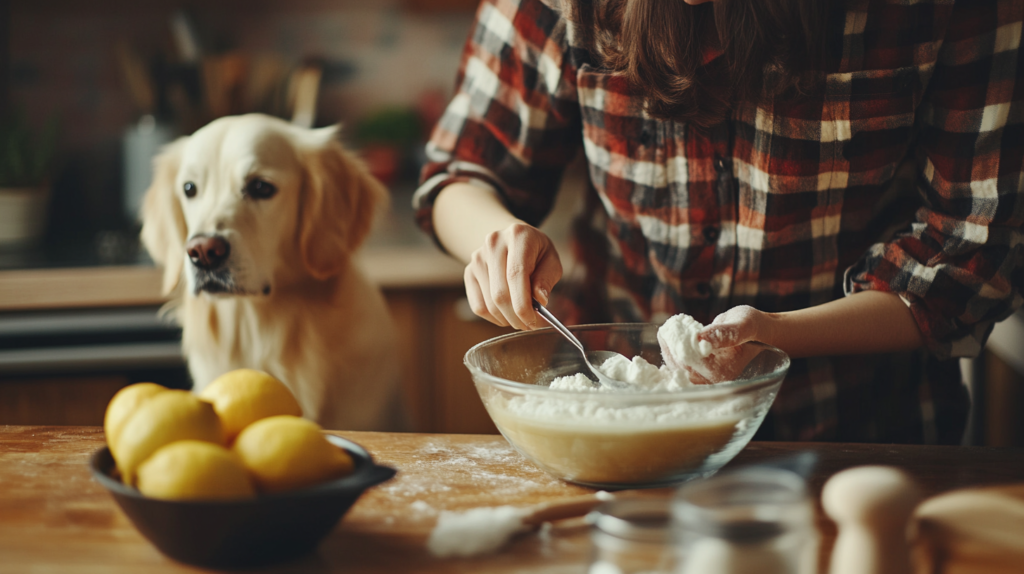
If you prefer making your own cleaning products or need an immediate solution before you can purchase pet-friendly alternatives, here are some DIY options using ingredients most people already have at home.
Basic All-Purpose Cleaner
Ingredients:
- 1 cup white distilled vinegar
- 1 cup water
- 10-15 drops of pet-safe essential oils like lavender or lemon (optional)
Directions:
- Combine ingredients in a spray bottle.
- Shake well before each use.
- Spray on surfaces and wipe clean.
Caution: Avoid using this solution on marble or natural stone surfaces as the acidity can cause damage.
Heavy-Duty Scrub for Stubborn Messes
Ingredients:
- 1/4 cup baking soda
- Enough hydrogen peroxide to make a paste
Directions:
- Mix ingredients to form a paste.
- Apply to stained areas and let sit for 5-10 minutes.
- Scrub and rinse thoroughly.
Window and Glass Cleaner
Ingredients:
- 1 part white vinegar
- 1 part water
- 2 drops liquid castile soap (optional, for extra cleaning power)
Directions:
- Combine in a spray bottle.
- Spray on glass surfaces.
- Wipe with a lint-free cloth or newspaper for a streak-free shine.
Carpet Deodorizer
Ingredients:
- 1 cup baking soda
- 10-15 drops of pet-safe essential oil (optional)
Directions:
- Mix ingredients thoroughly.
- Sprinkle liberally over carpet.
- Let sit for at least 30 minutes or overnight for strong odors.
- Vacuum thoroughly.
Seven Essential Tips for Cleaning with Pets in Mind
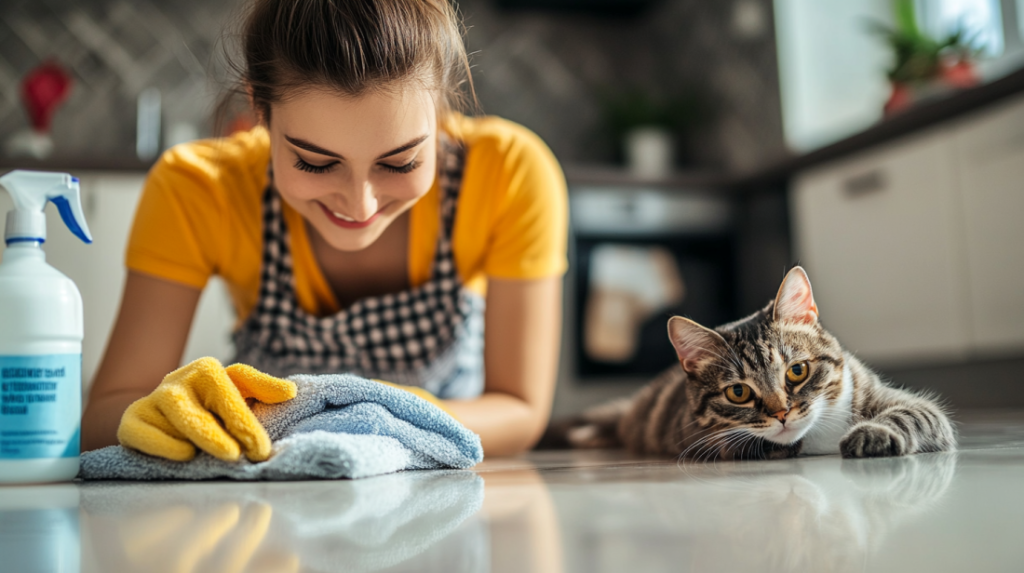
1. Establish a Regular Cleaning Schedule
Regular cleaning prevents buildup of dirt, allergens, and pet hair, reducing the need for harsh chemicals when messes become overwhelming. A consistent schedule of daily touch-ups and weekly deep cleans keeps your home fresh with minimal product use.
2. Practice Proper Product Storage
Even pet safe cleaning products should be stored securely away from curious pets. Keep all cleaning supplies in closed cabinets with childproof latches if necessary, especially for particularly determined pets.
3. Ventilate While Cleaning
When using any cleaning product, ensure proper ventilation by opening windows or using fans. This helps dissipate fumes quickly and reduces the risk of respiratory irritation for both pets and humans.
4. Follow Dilution Instructions
Even with pet safe cleaning products, always follow the manufacturer’s dilution guidelines. Using products at full strength when they should be diluted can increase the risk of irritation and waste product unnecessarily.
5. Rinse Well When Needed
For surfaces your pets directly contact—like floors, pet beds, or bathtubs—consider rinsing with clean water after cleaning, even when using pet-friendly products. This extra step provides additional safety for pets who might lick or chew these surfaces.
6. Consider Your Specific Pet’s Sensitivities
Some pets have individual sensitivities even to natural ingredients. Monitor your pet after introducing any new cleaning product for signs of irritation, respiratory distress, or skin reactions, and discontinue use if you notice any adverse effects.
7. Address Accidents Immediately
Prompt cleaning of pet accidents not only prevents staining but also reduces the amount of cleaner needed. The longer urine, feces, or vomit sits, the more difficult it becomes to remove, often requiring stronger cleaning agents.
Special Considerations for Different Types of Pets
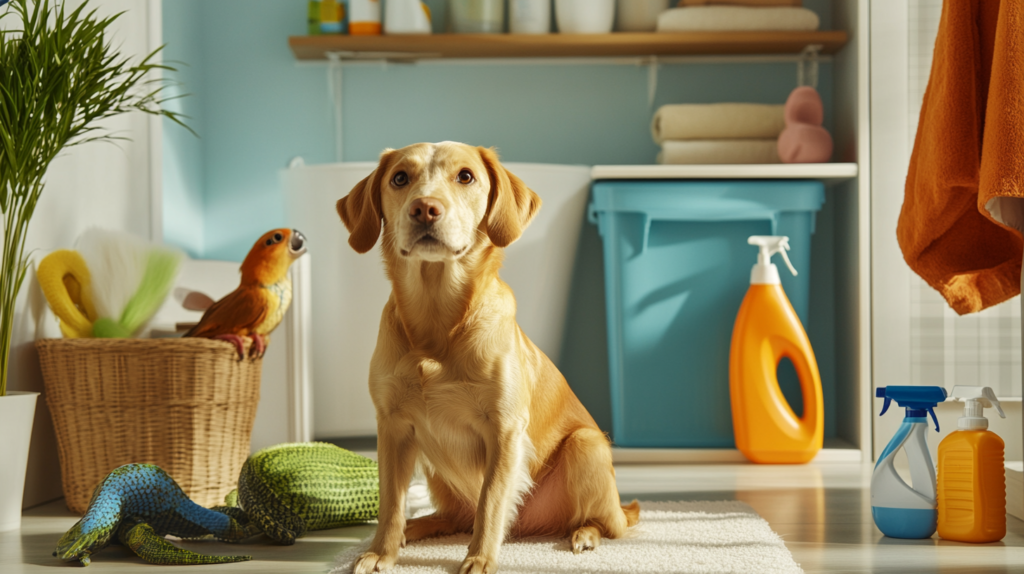
Different pets have varying levels of sensitivity to cleaning products. Here’s what to consider based on the type of pet you have:
Dogs
Dogs frequently lick their paws after walking on floors and may chew household objects, increasing their exposure to cleaning product residues. Floor cleaners and furniture polishes are particularly concerning for canine households.
Special tip: Use pet-friendly wipes to clean paws after walks to reduce tracking in outdoor contaminants that might mix with indoor cleaning residues.
Cats
Cats are meticulous groomers and have particularly sensitive respiratory systems. They’re especially vulnerable to phenol toxicity and essential oil toxicity.
Special tip: Avoid tea tree oil completely in homes with cats, even in “natural” cleaning products, as this essential oil can be toxic to felines even in small amounts.
Birds
Birds have extremely sensitive respiratory systems and can be fatally affected by airborne toxins that would merely irritate mammals.
Special tip: Never use aerosol products or air fresheners in homes with birds, and ensure complete ventilation for several hours after cleaning near bird habitats.
Small Mammals (Hamsters, Guinea Pigs, Rabbits)
These pets often live in enclosed spaces where cleaning product fumes can concentrate. They’re also likely to chew on cage materials that may have cleaning residues.
Special tip: When cleaning small mammal habitats, use only hot water and pet-safe detergents, followed by thorough rinsing and complete drying before returning the animal to its habitat.
Reptiles
Many reptiles absorb substances through their skin and can be sensitive to residues left on terrarium surfaces.
Special tip: For reptile enclosures, use hot water and minimal soap, followed by disinfection with reptile-safe products specifically designed for terrarium cleaning.
Fish
Fish are extremely vulnerable to water contaminants. Even trace amounts of cleaning products that get into aquarium water can be fatal.
Special tip: Never clean near an open aquarium and never spray any product that could potentially drift into the water. Cover aquariums completely during any household cleaning.
Understanding Labels: How to Identify Truly Pet Safe Cleaning Products

With greenwashing becoming increasingly common, it’s important to know how to identify genuinely pet safe cleaning products beyond marketing claims. Here’s what to look for:
Certification Logos to Trust
Look for third-party certifications that verify environmental and safety claims:
- EPA Safer Choice: Products with this label have been evaluated by the Environmental Protection Agency and determined to contain ingredients that are safer for humans, pets, and the environment.
- USDA Certified Biobased Product: Indicates a product contains a verified amount of renewable biological ingredients.
- Green Seal: Products with this certification meet strict environmental standards.
- EcoLogo: A third-party certification for products meeting strict health and environmental standards.
Reading Ingredient Lists
Learn to recognize red flags in ingredient lists:
- Transparency matters: Companies making truly pet safe cleaning products typically list all ingredients, not just active ingredients.
- Watch out for vague terms: “Fragrance” or “surfactant” without further specification could hide harmful chemicals.
- Beware of “natural” claims: The term “natural” is unregulated and doesn’t guarantee safety for pets.
Understanding Meaningless Terms
Some marketing terms have little regulatory backing:
- “Eco-friendly” has no standardized definition
- “Green” is a marketing term without regulatory significance
- “Non-toxic” is not verified by any regulatory body unless accompanied by specific certifications
Transitioning to Pet Safe Cleaning Products: A Step-by-Step Guide
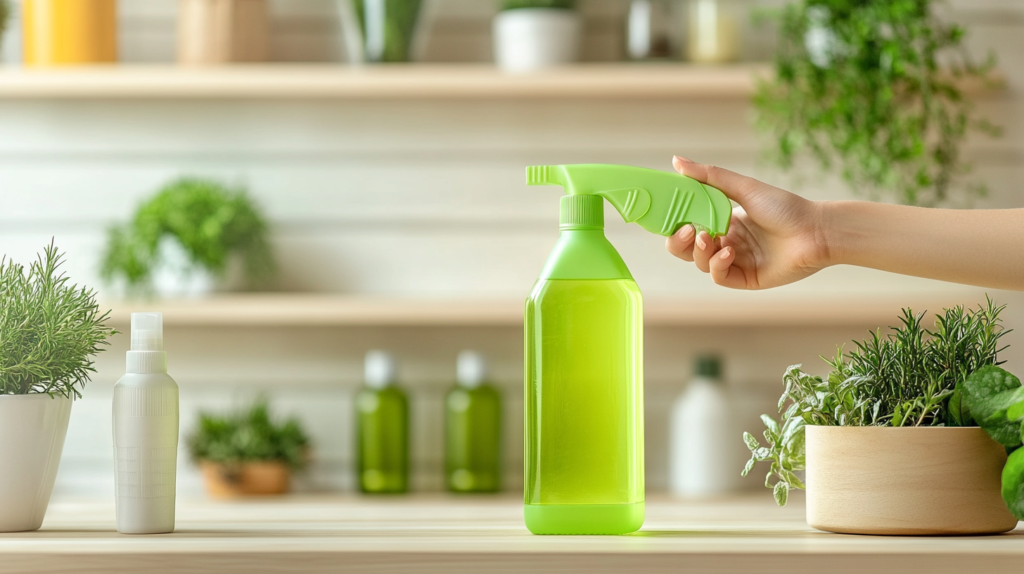
Making the switch to pet safe cleaning products doesn’t have to happen overnight. Here’s a practical approach to transitioning your household:
Step 1: Start with High-Risk Areas
Begin by replacing products used on floors, pet bedding, and in areas where your pets spend the most time.
Step 2: Replace Products as They Run Out
Instead of throwing away all your current cleaning supplies (which creates waste), replace each conventional cleaner with a pet-friendly alternative as it runs out.
Step 3: Create a Priority List
Some conventional cleaners pose more significant risks than others. Prioritize replacing:
- Air fresheners and fabric refreshers (often high in VOCs)
- Disinfectants containing phenols
- Ammonia-based cleaners
- Chlorine bleach products
- All-purpose cleaners used frequently
Step 4: Test New Products
Before fully committing to a new pet safe cleaning product, test its effectiveness on a small area to ensure it meets your cleaning standards.
Step 5: Educate Household Members
Make sure everyone in your home understands which products are safe to use around pets and how to properly store cleaning supplies.
How to Clean Specific Pet Messes with Pet Safe Products
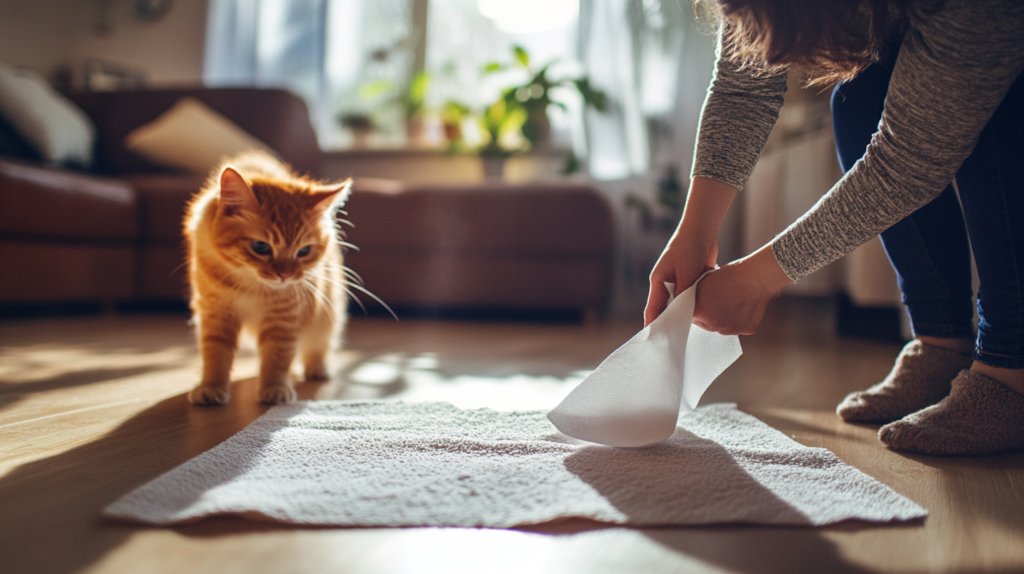
Pet ownership comes with specific cleaning challenges. Here’s how to tackle common pet messes using pet-friendly methods:
Urine Accidents
Fresh accidents:
- Blot up as much liquid as possible with paper towels or an absorbent cloth
- Apply an enzymatic cleaner like Biokleen Bac-Out directly to the affected area
- Let sit for the time recommended on the product (usually 10-15 minutes)
- Blot again and allow to air dry
For set-in urine stains and odors:
- Make a paste of baking soda and hydrogen peroxide
- Apply to the stained area
- Cover with a damp cloth and allow to sit for several hours
- Vacuum thoroughly
- Follow with an enzymatic cleaner for odor elimination
Pet Hair and Dander
- Use a vacuum with a HEPA filter regularly
- Between vacuuming, use a damp rubber glove or pet hair removal tool on furniture
- For hard floors, use a microfiber mop slightly dampened with a pet safe cleaner
- Launder pet bedding weekly in hot water with a fragrance-free, dye-free detergent
Food and Treat Stains
- Remove any solid debris
- Blot liquids with paper towels
- Apply a pet safe all-purpose cleaner like Seventh Generation Free & Clear
- For greasy stains, add a drop of dish soap to the solution
- Rinse with clean water if the surface allows
Muddy Paw Prints
- Let mud dry completely
- Vacuum or sweep up dried mud
- Wipe remaining residue with a damp microfiber cloth or mop using a diluted all-purpose pet safe cleaner
- For carpets, follow with a carpet cleaner suitable for pet households
Hairball or Vomit Cleanup
- Remove solid material using gloves and paper towels
- Blot any liquid with absorbent cloth
- Apply an enzymatic cleaner to break down proteins
- For carpets, follow with baking soda once dry, let sit for 30 minutes, then vacuum
The Impact of Cleaning Products on Indoor Air Quality in Pet Households
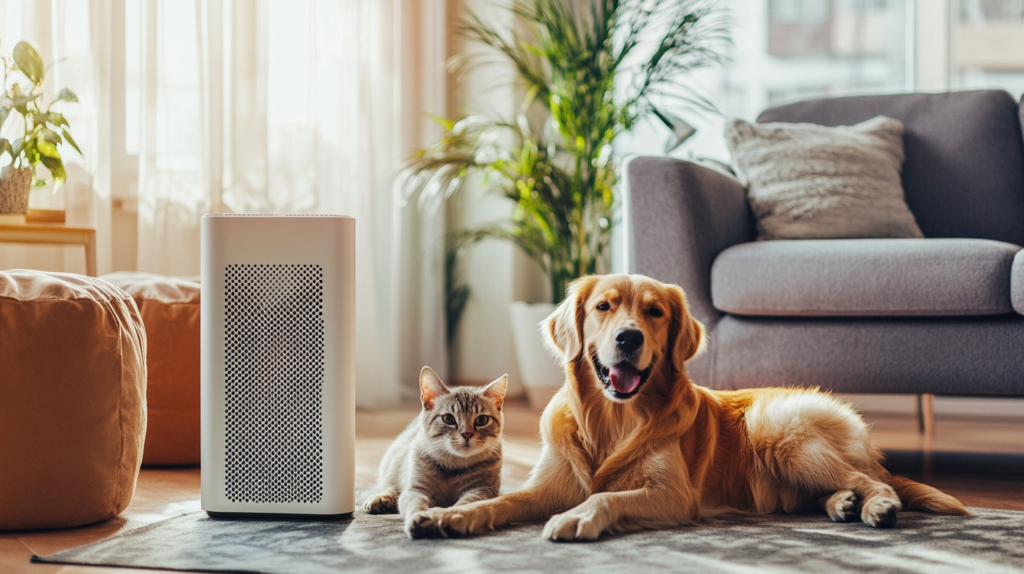
The products we use to clean our homes significantly impact indoor air quality, which directly affects our pets’ health. According to the EPA, indoor air can be 2-5 times more polluted than outdoor air, with cleaning products being major contributors to this pollution.
A 2019 study published in the Environmental Science & Technology journal found that many conventional cleaning products release volatile organic compounds (VOCs) that can remain in the air for hours after use. Since pets typically have faster respiratory rates than humans and spend more time in the home, they inhale more of these airborne toxins.
Dr. Melissa Kusewitt, a veterinary pulmonologist, explains: “Pets, especially birds and small mammals, have more sensitive respiratory systems than humans. What causes mild irritation for us can cause serious respiratory distress for them. The chemical burden from conventional cleaning products accumulates in their systems over time.”
To improve indoor air quality in pet households:
- Choose cleaning products with zero or low VOCs
- Avoid aerosol products
- Ensure adequate ventilation during and after cleaning
- Consider using air purifiers with HEPA filters
- Add air-purifying houseplants (ensure they’re non-toxic to your specific pets)
- Clean dust regularly, as dust can absorb and hold volatile chemicals
For more expert pet care tips and product recommendations, visit BlithePet.com — your trusted source for pet wellness.
Frequently Asked Questions About Pet Safe Cleaning Products
Is vinegar safe to use around pets?
Answer: Yes, white distilled vinegar is generally safe to use around pets when diluted properly. It’s an effective cleaner for many surfaces and helps neutralize odors. However, the strong smell may temporarily bother some pets, so ensure good ventilation when using it. Never use vinegar on marble or natural stone surfaces as it can cause etching.
Are essential oils in cleaning products safe for pets?
Answer: Some essential oils can be toxic to pets, particularly cats and birds. Oils to avoid include tea tree, pine, wintergreen, cinnamon, citrus (concerning for cats), and eucalyptus. If using products with essential oils, ensure they’re highly diluted and keep pets away from treated areas until completely dry. When in doubt, choose unscented products for the safest option.
Can I use hydrogen peroxide to clean pet accidents?
Answer: Hydrogen peroxide (3% solution) is generally safe for spot cleaning pet accidents when used properly. It works well on organic stains but may bleach some fabrics and surfaces, so always test in an inconspicuous area first. After application, rinse or blot thoroughly as ingestion of hydrogen peroxide can cause gastrointestinal upset in pets.
How do I know if my pet is having a reaction to a cleaning product?
Answer: Signs of adverse reactions include excessive scratching, red or irritated skin, coughing, sneezing, watery eyes, lethargy, vomiting, or changes in behavior after using a new cleaning product. If you notice any of these symptoms, discontinue use of the product immediately and consult your veterinarian if symptoms persist or worsen.
Are “green” or “natural” products automatically safe for pets?
Answer: No, “green” and “natural” are marketing terms without standardized definitions. Some natural ingredients like essential oils can be harmful to pets. Always check ingredients lists and look for products specifically tested for safety around animals. Third-party certifications like EPA Safer Choice provide more reliable indicators of safety than marketing claims alone.
How often should I clean my pet’s bedding and toys to minimize chemical exposure?
Answer: Pet bedding should be washed every 1-2 weeks using fragrance-free, dye-free detergents. Machine-washable toys should be cleaned monthly, while hard toys can be washed as needed with mild soap and water, followed by thorough rinsing. Regular cleaning prevents buildup of dirt and bacteria that might otherwise require stronger cleaning agents.
Conclusion: Creating a Safe and Clean Environment for Your Pets
Maintaining a clean home while keeping your pets safe is absolutely achievable with the right products and practices. By choosing pet safe cleaning products, you’re not only protecting your furry, feathered, or scaled family members from immediate harm but also potentially extending their lifespan by reducing their exposure to toxic chemicals over time.
Remember these key takeaways:
- Always read ingredient labels, not just marketing claims
- Look for third-party certifications like EPA Safer Choice
- Be especially cautious with products used on floors, pet bedding, and in areas where pets spend the most time
- Consider your specific pet’s species, size, and individual sensitivities
- Even with pet safe products, proper storage away from curious animals is essential
- Regular cleaning with gentle products is better than occasional deep cleaning with harsh chemicals
The small changes you make in your cleaning routine can have a significant impact on your pet’s health and wellbeing. By choosing products from our recommended list or following our guidelines for identifying pet safe cleaning products, you’re making an important investment in your pet’s long-term health while still maintaining a clean and comfortable home for the entire family.
Have a similar experience with your pet? Share it in the comments below!

